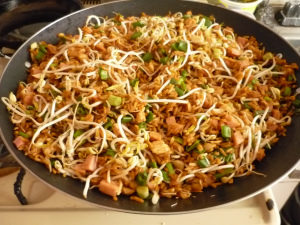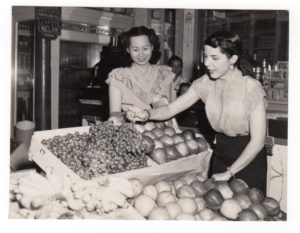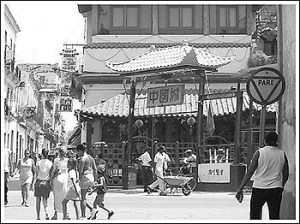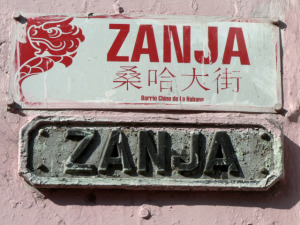Everything had a new meaning. The simple fact that they took me shopping for Christmas Eve excited me a lot, because I knew that we would go to the Cuatro Caminos single market, what they called the Plaza de Cuatro Caminos, where there was a bustle and a special animation in those days.
.. In the house, the women had already ordered, in the Chinatown, on San Nicolás Street, the roast duck and the Cantonese pork, all made with the best ingredients. My grandfather used to give the Chinese butcher some bottles of yellow Fukiang wine, ideal for cooking and flavoring the roasts. When he went to pick up the orders, he always gave me a good portion of Cha-Siu (Cantonese smoked pork) in a waxed paper wrapper. It devoured the contents in a few minutes and enjoyed that peculiar smoke flavor, with a light touch of anise and honey, whose flakes go from a lacquered red to a tender white, in a mouthful that almost melts on the palate.
The main food was always made by men, almost all restaurant chefs in which the family had some link with society or investments, such as El Nanking and El Pacifico, a restaurant located in the same building where part of my family lived, and where I spent a lot of free time out of school. There were also the Mandarin and the Polynesian, whose captain was my godmother’s husband, another expert cook and my culinary mentor.
The Banquet.
The guests were arriving, each with something to improve the banquet.
Rafael Eng, with his impeccable white guayabera of Creole thread that stands out on his smooth and hairless skin and big eyes that are never forgotten. He spoke an almost indecipherable Spanish and was kind and gentle, a faithful and jealous friend of the family. He was the chef of the Nanking restaurant, on one side of the Central Park, and he brought with him a platter of butterflies stuffed with shrimp paste with pork and bamboo shoots.
On the table, a strange mixture of creole and Chinese delicacies was appearing. An amalgam of colors and irresistible smells filled the senses. In the center, the pork roasted and smoked to the Chinese, with its skin crunchy and cut all in perfect dice -without deforming the animal-, which looked happy with an apple roasted in the mouth. At his side he could not miss the roast duck cantones, dismissing an aniseed aroma, as if they had given varnish to the tanned skin, for the brightness and the appetizing that was seen.
In one corner of the large table was a fountain of Chinese vegetables in a smoky rainbow: turnips, chard, pak-choy, bok-choy, cailan and cundiamor were joined to carrots, radishes, mushrooms of various types cut into thin strips, and the unmistakable agar-agar, or black algae, so fragrant and delicate. Everything was covered with a frost of chives and ginger.
Another source contained chicken wings crystallized with honey and oyster sauce, which did not rival the large battered shrimp and shared their space with the croquettes made of beef skirt, with crunchy béchamel in its thin outer layer but pure cream in its content, and its taste so Spanish. Beside it stood out the cauldron with the best black bean in the world, curdled, asleep and smoky, as Chinese-Cuban, who waited anxiously for his best companion, that white rice, smooth and tasty, bathed in pork lard that makes it pearled The tostones and the fried plantain, well fried, wait for the last-minute bath of a sauce made with the substance left in the pan where the pork was made and other dressings that culminate their flavor with a good amount of Chinese cilantro finely chopped up. All this to wet the bread, which was not lacking, or grandma’s cod fritters. And in a corner, waiting, the Creole salad in case someone got nostalgia at the last minute. The fried maripositas were the signal for everyone to sit at the table. Someone mentioned yucca with mojo, but no one paid attention to it because the table was already full, there was no space for fried rice or for Chop-Suey, because they are not traditional Chinese dishes:
– They are food for customers- says Rafael and everyone nodded.
Around us were the Cubans: my cousins and I, the uncles of China and Spain, my godmother, who was the perfect mix of all. They spoke Spanish and Cantonese and even made jokes about the Galicians, while my grandmother became serious and said something small in her perfect mixture of Galician and Catalan.
To provide, good Spanish wine and Chinese rice wine, which is really brandy, yellow, strong, and that I watched with great interest because I love collecting those round, pot-bellied and flat bottles, of a black porcelain, matted by outside and white shiny inside. For children, malts or soft drinks: Materva, Salutaris, Coca-Cola and their rival the Pepsi, although others preferred the Ironbeer or the Jupiña or the Cawy in their blue logo, to me the Orange-Crush or the Green Spot. The grandfather, his black beer Cabeza de Perro and the young guys, Hatuey or Polar beers, although we did not forget La Tropical because he invited us to his festivals every year on the retailer’s day.
Desserts are the Creole contribution: Spanish nougat, candied fruit and donut with its magic syrup and sweet orange segments. In addition, with the food there was jasmine tea for the traditional and safe Creole coffee at the end.
We were all happy. We raised glasses and glasses, we heard a mixture of Merry Christmas with – Kun-Ji-Fa-Choey-, and the great feast began. I was contemplating, without knowing it, that this would be the last time we would all be together around a table. It was December 24, 1958. Outside, firecrackers and fliers resounded while the happy family enjoyed Chinese-Cuban Christmas Eve in a scene that would never be repeated.
“MI ÚLTIMA NOCHEBUENA CHINO-CUBANA EN LA HABANA”. por Alfredo Pong.
Todo tenía un significado nuevo. El simple hecho de que me llevasen a hacer las compras para la Nochebuena me excitaba mucho, pues sabía que iríamos al mercado único de Cuatro Caminos, lo que llamaban la Plaza de Cuatro Caminos, donde había un bullicio y una animación especial en esos días.
.. En la casa, las mujeres ya habían encargado en el barrio chino, en la calle San Nicolás, el pato asado y el puerco a lo cantonés, todo confeccionado con los mejores ingredientes. Mi abuelo acostumbraba a regalarle al carnicero chino unas botellas de vino de Fukiang amarillo, ideal para cocinar y aromatizar los asados. Al ir a recoger los encargos siempre me regalaba una buena porción de Cha- Siu (puerco ahumado a lo cantonés) en un envoltorio de papel encerado. Devoraba el contenido en pocos minutos y disfrutaba de ese sabor tan peculiar a ahumado, con un leve toque de anís y miel, cuyas lascas van de un rojo laqueado a un blanco tierno, en un bocado que casi se deshace en el paladar.
La comida principal siempre era confeccionada por los hombres, casi todos cocineros de restaurantes en los que la familia tenía algún vinculo de sociedad o inversiones, como El Nanking y El Pacifico, restaurante ubicado en el mismo edificio donde vivía parte de mi familia, y donde pasaba buena parte del tiempo libre extraescolar. También estaban el Mandarín y el Polinesio, cuyo capitán era el esposo de mi madrina, otro experto cocinero y mi mentor culinario.
El Banquete.
Iban llegando los invitados, cada uno con algo para mejorar el banquete.
Rafael Eng, con su impecable guayabera blanca de hilo criolla que destaca sobre su piel tersa y lampiña y unos grandes ojos que nunca se olvidan. Hablaba un español casi indescifrable y era bondadoso y gentil, un fiel y celoso amigo de la familia. Era el cocinero del restaurante Nanking, a un costado transversal al Parque Central, y traía consigo una fuente de maripositas rellenas de pasta de camarones con puerco y retoño de bambú.
Sobre la mesa, iban apareciendo una extraña mezcla de manjares criollos y chinos. Una amalgama de colores y olores irresistibles llenaban los sentidos. En el centro, el puerco asado y ahumado a lo chino, con su pellejo crujiente y cortado todo en dados perfectos -sin deformar al animal-, que lucía feliz con una manzana asada en la boca. A su lado no podía faltar el pato asado cantones, despidiendo un aroma anisado, como si le hubiesen dado barniz a la piel tostada, por el brillo y lo apetitosa que se veía.
En una esquina de la gran mesa había una fuente de vegetales chinos en un arcoiris humeante: nabos, acelgas, pak-choy, bok-choy, cailan y cundiamor se unían a zanahorias, rábanos, hongos de varios tipos cortados en tiras finas, y el inconfundible agar-agar, o algas negras, tan olorosas y delicadas. Todo estaba cubierto con una escarcha de cebollinos y jengibre.
Otra fuente contenía alas de pollo cristalizadas con miel y salsa de ostiones, que no rivalizaban con los camarones rebozados grandes y que compartían su espacio con las croquetas hechas de carne de falda de res, con bechamel crujiente en su fina capa exterior pero pura crema en su contenido, y su sabor tan español. A su lado destacaba el caldero con el mejor frijol negro del mundo, cuajado, dormido y humeante, a lo chino-cubano, que esperaba ansioso a su mejor compañero, ese arroz blanco, terso y sabroso, bañado en manteca de puerco que lo hace perlado. Los tostones y el plátano maduro frito, bien amelcochados, esperan por el baño de último momento de una salsa hecha con la sustancia que queda en la paila donde se hizo el puerco y otros aderezos que culminan su sabrosura con una buena cantidad de cilantro chino finamente cortado. Todo esto para mojar el pan, que no faltaba, o las frituras de bacalao de la abuela. Y en una esquina, esperando, la ensalada criolla por si a alguno le entraba la nostalgia a última hora. Las maripositas fritas eran la señal para que todos se sentaran a la mesa. Alguien mencionó la yuca con mojo, pero nadie le hizo caso pues ya la mesa estaba a tope, no había espacio, ni para el arroz frito ni para el Chop- Suey, porque no son platos chinos tradicionales:
– Son comida para clientes- dice Rafael y todos asienten con la cabeza.
A su alrededor estábamos los cubanos: mis primos y yo, los tíos de China y España, mi madrina, que era la perfecta mezcla de todos. Se hablaban español y cantonés y hasta se hacían chistes sobre los gallegos, mientras mi abuela se ponía seria y decía algo bajito en su perfecta mezcla de gallego y catalán.
Para brindar, buen vino español y vino de arroz chino, que en realidad es aguardiente, de color amarillo, fuerte, y que yo vigilaba con mucho interés porque me encanta coleccionar esas botellas redondas, barrigonas y chatas, de una porcelana negra, mate por fuera y blanca brillosa por dentro. Para los niños, maltas o refrescos: Materva, Salutaris, Coca-Cola y su rival la Pepsi, aunque otros preferían el Ironbeer o la Jupiña o el Cawy en su logo azul, a mi el Orange-Crush o el Green Spot. El abuelo su cerveza negra Cabeza de Perro y los tios jóvenes cervezas Hatuey o Polar, aunque no olvidábamos La Tropical porque nos invitaba a sus verbenas todos los años en el día del Detallista.
Los postres son el aporte criollo: los turrones españoles, las frutas confitadas y el buñuelo con su mágico almibar y los gajos de naranja dulces. Además, con la comida había té de jazmín para los tradicionales y de seguro café criollo al final.
Todos éramos felices. Alzamos vasos y copas, se escuchaba una mezcla de Feliz Navidad con – Kun-Ji-Fa- Choey-, y comenzó el gran festín. Contemplaba, sin saberlo, que esta sería la última vez que estaríamos juntos todos alrededor de una mesa. Era el 24 de diciembre del 1958. Afuera resonaban petardos o voladores mientras la familia feliz disfruta la Nochebuena chino-cubana en una escena que nunca más se iba a repetir.
Agencies/14ymedio, La Habana/Alfredo Pong/Internet Photos/ Arnoldo Varona/ TheCubanHistory.com
THE CUBAN HISTORY, HOLLYWOOD.














